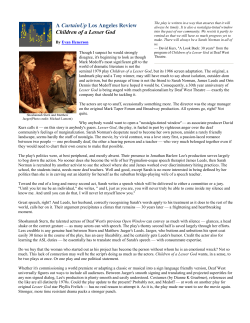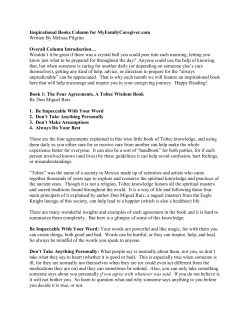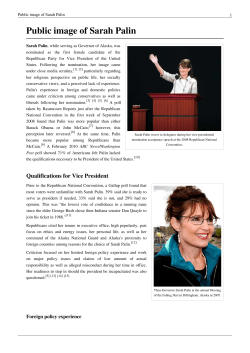
1. CHOMSKY'S OBSERVATIONS 2. EXPERIMENTS WITH "PRE-LANGUAGE" CHILDREN 3. STAGES OF ACQUISITION
LINGUISTICS 1, WEB QUIZ #6 1. CHOMSKY'S OBSERVATIONS 2. EXPERIMENTS WITH "PRE-LANGUAGE" CHILDREN 3. STAGES OF ACQUISITION 4. ACQUISITION OF PHONOLOGY (PRONUNCIATION) 5. ACQUSITION OF WORDS AND MEANINGS 6. DO ADULTS TEACH CHILDREN LANGUAGE? 7. HOW DO CHILDREN ACQUIRE LINGUISTIC PATTERNS? 8. DO CHILDREN MAKE LINGUISTIC ERRORS? 9. WHAT DO CHILDREN LISTEN FOR? 10. ACQUISTION OF A SECOND LANGUAGE BY ADULTS 1. CHOMSKY'S OBSERVATIONS [NOTE: I'm not sure where "Chomsky's observations" first appeared in print, but they are now part of the standard linguistics "lore".] Noam Chomsky has made the following observations about children acquiring language (course reader, page 95): • Rapidity of acquisition • Acquisition without special instruction • Acquisition based on exposure to randomly encountered input WHICH ONE OF THE FOLLOWING STATEMENTS BEST CHARACTIZES THE RELEVANCE OF THESE OBSERVATIONS FOR THE CLAIM THAT LANGUAGE IS AN "INSTINCT"? a. Children, if exposed to a language in the normal way, will automatically acquire it in the same way that they automatically develop physical attributes that are genetically specific to humans. b. Children's brains are more "plastic" than the brains of adults, and they therefore have the capacity to acquire all sorts of abilities that become difficult for adults. c. Children are born with "grammar genes", but these shut down after a few years as the brain must turn its energies to other cognitive functions. d. Language is such an important ability that children are genetically predisposed to acquiring this ability before other abilities, such as doing math or playing musical instruments. e. Chomsky's observations don't stand up to close scrutiny: 4-5 years isn't all that "rapid", and children's caretakers provide much more "special instruction" and "specially structured input" than is generally acknowledged. 1 Linguistics 1, Web Quiz 6 2 2. EXPERIMENTS WITH "PRE-LANGUAGE" CHILDREN Here is a diagram of a set up for a Conditioned Head Turn procedure used to test speech perception of infants. The diagram comes from this paper: http://infantstudies.psych.ubc.ca/uploads/forms/1252960095WerkerPolkaPegg_1997.pdf Reinforcer = animated and colorful toy E1 = Experimenter 1 (holds infant's attention with "Toys") E2 = Experimenter 2 (runs experiment, hidden from others) Toys = stuffed animals, etc. (used to hold infant's attention) In question #4 below, we see that Sarah says, "Da," for both duck and dog. Suppose that we want to test whether she can PERCEIVE the difference between the vowels in these words by using the stimuli duck [duhk] and dock [dak] (because of font problems on web pages, "uh" is substituted for the "upside down v" in 'but' in the table on page 60 of the course reader). USING THE SET-UP SHOWN IN THE DIAGRAM, WHICH OF THE FOLLOWING WOULD DEMONSTRATE THAT SARAH COULD DISTINGUISH BETWEEN THESE VOWELS? a. After training, Sarah would hear duck-duck-duck-duck-dock and after the fourth repetition of duck, she would turn in the direction of the reinforcer in anticipation of hearing dock. b. After training, Sarah would hear duck-duck-duck-duck-dock and turn in the direction of the reinforcer before the toy lit up. c. After training, Sarah would hear duck-duck-duck-duck-dock, and after hearing dock, she would wait for the reinforcer to light up, then turn toward it. d. After training, Sarah would hear duck-duck-duck-duck-dock. After each repetition of duck, she would turn toward the reinforcer, then turn back, but upon hearing dock, she would fix her gaze on the reinforcer and not turn back. e. After training, Sarah would be attracted by the reinforcer, then hear dock-duck-duckduck-duck. As soon as she heard duck for the first time, she would turn away from the reinforcer. Linguistics 1, Web Quiz 6 3 3. STAGES OF ACQUISITION Video clips that can be seen here show Melissa at roughly three stages of language development. In each clip she uses the word "see" as part or all of her utterance. 21 months (one word) 23.4 months (two word) 25.2 months (telegraphic) (computer facing away so that she can't see the screen) Melissa: See...see, see. (turns computer around; music stops) Melissa: Oh boy! (tries to restart it) (on bed, stack of pillows covering Bubbles, a stuffed animal) Melissa: Ah! Bubbles! I see. Grandma: Oh! Bubbles was there! You were sitting on him. (in bedroom with Mom) Mom: Look, Melissa. You used to wear this. (doorbell rings) Melissa: Oh! That's Grandma. Grandpa: Shall we go say... shall we go let Grandma in? Melissa: OK. Let's see Grandma's here. (runs to living room) Let's see Grandma's here. ... (pointing to door) You ARE there! WHICH ONE STATEMENT BEST CHARACTERIZES STAGES IN LANGUAGE DEVELOPMENT AS PART OF COGNITIVE DEVELOPMENT? a. Complexity in language structure matches complexity of conceptual ability in general. b. A child moves from linguistically "labeling" salient concepts to applying a larger and larger repetoire of rules that combine those "labels" into more complex linguistic structures. c. Children become better and better at imitating the speech patterns of adults as they grow older. d. Children progressively move from speaking ungrammatically to speaking grammatically. e. At the earlier stages, words like 'see' in these examples are more or less "categoryless", but firming words up into true categories like VERB and NOUN allows the child to create complex structures like VP and NP. Linguistics 1, Web Quiz 6 4 4. ACQUISITION OF PHONOLOGY (PRONUNCIATION) A video clip that can be seen here shows Sarah at the one-word stage (17.1 months). The main interest here is Sarah's linguistic abilities that are revealed by the items in red. Mom: Sarah, what's this? Sarah: Da! M: (showing picture) That's right! It's a duck! S: Da! M: That's right! What's this? S: Da! M: (showing picture) That's right! It's a dog! (gives book to Sarah, who giggles) Grandpa: Can you find the dog? (Sarah giggles) Where's the dog? (Sarah points to picture of a dog) Yep! G: Can you find the fish? (Sarah points to picture of a fish) Yep! G: Can you find the duck? Where's the duck? (Sarah points to picture of a duck) That's right! That's a duck! Uh-huh! Which of the following statements BEST ACCOUNTS FOR THE FACTS HIGHLIGHTED IN RED? a. Sarah has a "word" [da] that is a general term for any living creature. b. Sarah has looked at this book so many times that she has memorized how adults have labeled the pictures. c. Sarah is being coached by adults as she is asked to name pictures or to point to specific pictures. d. Sarah has the mental ability to apply duality of patterning, but her speech consists of meaning elements that cannot be broken down into meaningless sounds. e. Sarah has the concept of duality of patterning, but her ability to apply it in her mental repertoire exceeds her current level of application in her speech. Linguistics 1, Web Quiz 6 5 5. ACQUSITION OF WORDS AND MEANINGS A video clip that can be seen here shows Melissa at the beginning of the one-word stage (16.2 months). (Melissa playing with small plastic animals) Grandpa: That's a sheep and that's a cow. (Melissa plays with sheep) Baa! He says, "Baa!" (Melissa look quizzically) Sheep says, "Baa!" Melissa: (holding sheep and thinking) Ba. ... Ba. (reaches into container and pulls out a toy horse) Melissa: Ba, ba. Grandpa: That's a horse. ... Horse. WHICH ONE OF THE FOLLOWING STATEMENTS BEST ACCOUNTS FOR MELISSA'S USES OF THE ba IN RED? a. Melissa has not yet acquired the Whole Object Principle--instead of calling the whole animal a "sheep", she names one of its "parts", in this case, the sound it makes. b. Melissa has not yet acquired the Lexical Contrast Principle, which says that when one hears a new word, the assumption is that it must refer to something for which we do not yet have a name. c. Melissa has not yet acquired the Mutual Exclusivity Principle, which says that different objects should have different names. d. As Melissa hears a new word (like Grandpa's word "Baa"), she is making hypotheses about what the word might mean, for example, "small toy animal", then applying this hypothesis. e. Melissa has a new word that sounds nice, so she is taking the opportunity to use it. 6. DO ADULTS TEACH CHILDREN LANGUAGE? The video on child language acquisition gave an example of how children interpret certain sentences using a story about a boy who fell out of a tree, then discovered his injury later when taking a bath. (Click here to see a clip from the video.) Linguistics 1, Web Quiz 6 6 CLAIM: This experiment provides good evidence that children learn complex grammar without being taught. FOUR of the answers in (a-e) seem like good support for this claim. Which ONE would NOT furnish much, if any support for the claim? a. The children did not all use the same wording in their responses. b. Adults seemed puzzled as to why one question had two possible answers and the other only one possible answer. Since they were puzzled themselves, they couldn't have taught the children. c. A number of children, clearly of varying backgrounds, were completely consistent in their responses. d. These questions involve grammatical complexity far beyond what children this age would learn in school, much less learn from parents who are not trained in grammar instruction. e. The children had no trouble understanding what was being asked and were able to give sensible repsonses. 7. HOW DO CHILDREN ACQUIRE LINGUISTIC PATTERNS? We can line up sentences as following certain patterns. Though the sentences on the left and right share patterns (shown by the labels in smaller type), the sentences on the left are fine whereas those marked with the * on the right are not heard. (1) (2a) (2b) THE PATTERN IS OK I painted a barn red. Subject Verb He NP Adjective seems happy. Subject Verb Does he DO Subject “Modifier” seem happy? Verb “Modifier” SIMILAR PATTERN IS NOT OK *I Subject He saw is Verb Subject Verb *Does he DO Subject a barn red. NP Adjective smiling. “Modifier” be smiling? Verb “Modifier” The video on child language (course reader, page 81--see also top of page 91) and Pinker (page 276) claim that children, during acquisition, would never make errors of the type shown by the “starred” examples (marked by the *). What is the basis of their claim? Linguistics 1, Web Quiz 6 7 a. Children are born with innate rules that they can use to form the sentences on the left, but not the starred sentences on the right. b. Children acquire language patterns by formulating rules that generate those patterns, not by copying patterns through analogical reasoning. c. Children would have heard the sentences on the left from adults, but they would not have heard the starred sentences on the right. d. Statistics: transcripts of child language show many sentences of the type on the left, but not of the starred types on the right. e. The sentences on the left would have a functional value in communication, whereas the starred sentences on the right would not. 8. DO CHILDREN MAKE LINGUISTIC ERRORS? Here are a couple of utterances by children from the video. (Click here to see a clip from the video.) “They drived to school.” “What do you think whatʼs in there?” The video asks the question, "Are they really errors?" Clearly they do not conform to adult English. WHY DOES THE VIDEO SUGGEST THAT THEY ARE NOT "ERRORS"? a. Though they do not conform to the rules of English, they do conform to the rules of some other languages. b. These sentences and words are probably repetitions of things that they have heard other people (adults or children) say and are thus "correct" in the sense that they are faithful to some "model", even though it is not standard English. c. These sentences and words conform to mental rules that the child has formulated at the current stage of acquisition. They are thus not "errors" in terms of the child's current mental grammar. d. Like all languages, English shows considerable dialect variability. When children make these "errors", they are just speaking a non-standard variety of English. e. These "errors" are just slips of the tongue. The children probably know better. Linguistics 1, Web Quiz 6 8 9. WHAT DO CHILDREN LISTEN FOR? In the video that we saw in class, one experiment showed that a baby in the pre-speech period could correctly identify who was washing whom? In another film on language acquisition, Out of the Mouths of Babes, a 3.5 year old girl is asked to show, "The car is bumped by the truck." She takes the car and bumps the truck with it. (Click here to see a clip from the video.) “Whereʼs Cookie Monster washing Big Bird.” Could you show us, “The car is bumped by the truck.” WHAT INFORMATION DO THESE CHILDREN SEEM TO BE RELYING ON AS THEY MENTALLY ANALYZE THE LINGUISTIC INPUT? a. The most common order for English sentences is SVO. b. It is a linguistic universal that Subjects come before Objects. This fact must therefore be part of the Language Instinct that children are born with. c. The children are watching the adults for non-linguistic cues such as eye gaze, head or hand movements, and the like. d. Children select the most likely agent of the action based on likelihood of which event would take place. For example, in the second example, the car toy is bigger than the truck toy and thus is more likely to be the "bumper", and in the other video, Big Bird is more likely to wash Cookie Monster than vice versa. e. Children tend to be good guessers, but once in awhile they guess wrong, as in the case of the little girl, who reversed who bumps who. 10. ACQUISITION OF A SECOND LANGUAGE BY ADULTS Here are two selections from an interview in English with an adult native speaker of Japanese, who was probably in his mid-30's at the time. (Click here to hear the two clips.) INTERVIEWEE In response to a question about whether zoos perform a valuable service of preserving IDIOMATIC ENGLISH VERSION Linguistics 1, Web Quiz 6 endangered species even though a zoo is a sort of "jail for animals". Yeah, of course, I agree that today's endangered species have to take care. But why today some ... many species wild animal are endangered? It's our fault, so I don't know. In response to a question about what drives US relations with other countries Oh for example some dictatorship country even rooks like friendry, I don't know really friendly country or not. So, American foreign policy rooks ... doesn't rook very oriented by friendly country. 9 Yeah, of course I agree that today's endangered species have to be taken care of. But why, today, are some ... many species of wild animals endangered? It's our fault, so I don't know. Oh, for example, some country that is a dictatorship even looks like it is friendly, (but) I don't know whether it is really a friendly country or not. So American foreign policy looks ... doesn't look to be very oriented toward (truly) friendly countries. Some of the errors in this speaker's English are marked by various colors. One assumes that these are interference errors, that is errors brought about because of differences between Japanese and English. WHICH ONE OF THE FOLLOWING SUGGESTIONS ABOUT DIFFERENCES BETWEEN ENGLISH AND JAPANESE SEEMS LEAST LIKELY? a. The phrase in blue suggests that if Japanese has a passive construction at all, it does not use the pattern of the English passive. (The English passive makes the OBJECT of an action into the SUBJECT and adds a helping verb "be", for example someone read the book --> PASSIVE the book was read.) b. The phrase in red suggests that Japanese does NOT add a plural-marking affix to nouns, even when they are understood as plural. c. The phrase in red suggests that the Japanese language lacks the ability to distinguish "one" from "more than one". d. The phrase in purple suggests that Japanese doesn't distinguish between r and l. e. The phrase in purple suggests that Japanese either doesn't have a verb 'be' or uses 'be' in ways that are different from the way it is used in English.
© Copyright 2025



















